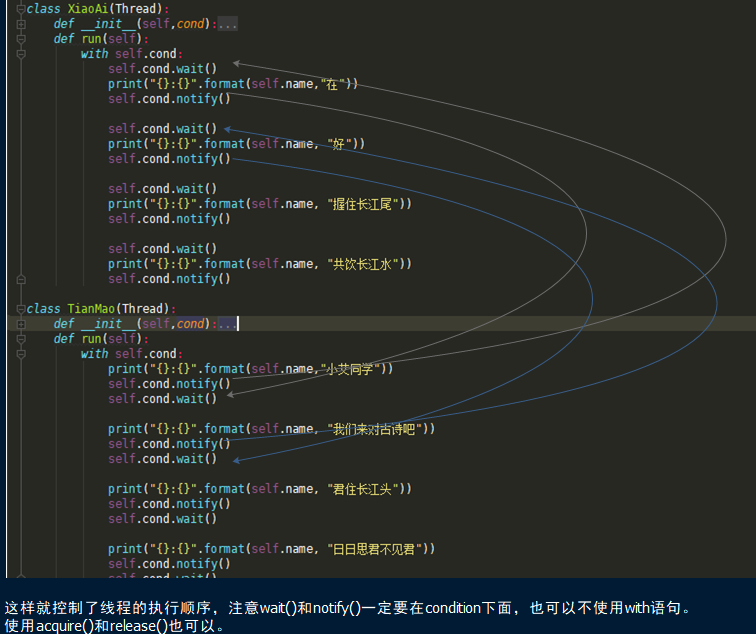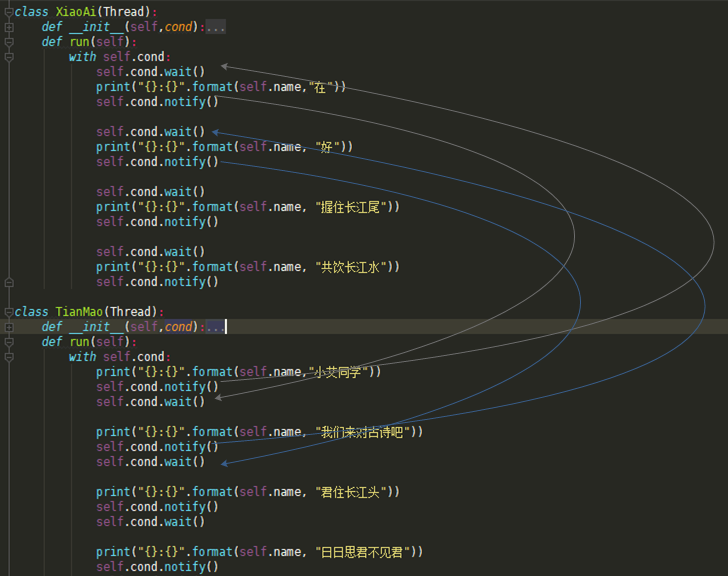在多线程编程中,有两个必须要解决的问题,
一个是线程通信,另一个是线程同步问题。
from threading import Thread from multiprocessing import Process a = 0 def add(): global a b = 0 for i in range(1000000): a += 1 def desc(): global a for i in range(1000000): a -= 1 def task(): t1 = Thread(target=add) t2 = Thread(target=desc) t1.start() t2.start() t1.join() t2.join() print(a) if __name__ == "__main__": for i in range(4): p = Process(target=task) p.start() p.join()
执行结果:
-557629
478789
444414
-12991
原因分析:
关键在于赋值上面,当某个时间段,t1说a = 5000,t2说a=3000,那么到低是5000还是3000了,
谁先执行听谁的,如果a=3000,对于t1来说,问题就出现了。
解决方法一:
t1.start()
t1.join()
t2.start()
t2.join()
如果让现场顺序执行,那就没有问题了,但是这样多线程就没有意义。
1.Lock
既然赋值的时候可能出现竞争,那么就给他上一把锁。
让它同一时刻,只有一个代码段可以运行。
from threading import Thread,Lock from multiprocessing import Process a = 0 def add(lock): global a b = 0 for i in range(1000000): lock.acquire() a += 1 lock.release() def desc(lock): global a for i in range(1000000): lock.acquire() a -= 1 lock.release() #一定要释放掉 def task(): lock = Lock() t1 = Thread(target=add,args=(lock,)) t2 = Thread(target=desc,args=(lock,)) t1.start() t2.start() t1.join() t2.join() print(a) if __name__ == "__main__": for i in range(4): p = Process(target=task) p.start()
执行结果:
0
0
0
0
但是用锁会影响性能,同时可能会引起死锁。
由于资源竞争最容易出现死锁的状况。
2.RLook:可重用锁
在一个线程里面,可以连续调用多次acquire,但是release的次数一定要相等。
lock.acquire()
lock.acquire()
a += 1
lock.release()
lock.release()
对于lock来说,使用锁之前所以一定要释放掉,上述代码肯定出错。
只要使用可重用锁就行:
lock = RLook()
3.condition的使用以及源码分析
condition(条件变量)是python中提供了另一个用于复杂的线程间同步的锁。
如果我们要实现以下对话:
天猫精灵:小艾
小艾:在
天猫精灵:我们来对古诗吧
小艾:好
天猫精灵:君住长江头
小艾:我住长江尾
天猫精灵:日日思君不见君
小艾:共饮长江水
天猫精灵:此水几时休
小艾:此恨何时已
天猫精灵:只愿君心似我心
小艾:定不负相思意
前面两句还好:
from threading import Thread class XiaoAi(Thread): def __init__(self): super().__init__(name="小艾") def run(self): print("{}:{}".format(self.name,"在")) class TianMao(Thread): def __init__(self): super().__init__(name="天猫精灵") def run(self): print("{}:{}".format(self.name,"小艾同学")) if __name__ == "__main__": tianmao = TianMao() xiaoai = XiaoAi() tianmao.start() xiaoai.start() 执行结果: 天猫精灵:小艾同学 小艾:在
但是说话的时候只能允许一个人说,因此上个锁。
from threading import Thread,Lock class XiaoAi(Thread): def __init__(self,lock): super().__init__(name="小艾") self.lock = lock def run(self): self.lock.acquire() print("{}:{}".format(self.name,"在")) self.lock.release() class TianMao(Thread): def __init__(self,lock): super().__init__(name="天猫精灵") self.lock = lock def run(self): self.lock.acquire() print("{}:{}".format(self.name,"小艾同学")) self.lock.release() if __name__ == "__main__": lock = Lock() tianmao = TianMao(lock) xiaoai = XiaoAi(lock) tianmao.start() xiaoai.start() 执行结果: 天猫精灵:小艾同学 小艾:在
但是如果要全部打印
from threading import Thread,Lock class XiaoAi(Thread): def __init__(self,lock): super().__init__(name="小艾") self.lock = lock def run(self): self.lock.acquire() print("{}:{}".format(self.name,"在")) self.lock.release() self.lock.acquire() print("{}:{}".format(self.name, "好")) self.lock.release() class TianMao(Thread): def __init__(self,lock): super().__init__(name="天猫精灵") self.lock = lock def run(self): self.lock.acquire() print("{}:{}".format(self.name,"小艾同学")) self.lock.release() self.lock.acquire() print("{}:{}".format(self.name, "我们来对古诗吧")) self.lock.release() if __name__ == "__main__": lock = Lock() tianmao = TianMao(lock) xiaoai = XiaoAi(lock) tianmao.start() xiaoai.start() 执行结果: 天猫精灵:小艾同学 天猫精灵:我们来对古诗吧 小艾:在 小艾:好
我们发现并不是我们期待的顺序,那么如何控制线程的切换顺序了。
from threading import Thread,Condition class XiaoAi(Thread): def __init__(self,cond): super().__init__(name="小艾") self.cond = cond def run(self): with self.cond: self.cond.wait() #先等待通知 print("{}:{}".format(self.name,"在")) self.cond.notify() #执行完代码之后,通知对方我执行完了你可以接着执行 self.cond.wait() print("{}:{}".format(self.name, "好")) self.cond.notify() self.cond.wait() print("{}:{}".format(self.name, "握住长江尾")) self.cond.notify() self.cond.wait() print("{}:{}".format(self.name, "共饮长江水")) self.cond.notify() class TianMao(Thread): def __init__(self,cond): super().__init__(name="天猫精灵") self.cond = cond def run(self): with self.cond: print("{}:{}".format(self.name,"小艾同学")) self.cond.notify() #通知 self.cond.wait() #等待小艾执行完代码,发送通知过来 print("{}:{}".format(self.name, "我们来对古诗吧")) self.cond.notify() self.cond.wait() print("{}:{}".format(self.name, "君住长江头")) self.cond.notify() self.cond.wait() print("{}:{}".format(self.name, "日日思君不见君")) self.cond.notify() self.cond.wait() if __name__ == "__main__": cond = Condition() tianmao = TianMao(cond) xiaoai = XiaoAi(cond) xiaoai.start() tianmao.start() 执行结果: 天猫精灵:小艾同学 小艾:在 天猫精灵:我们来对古诗吧 小艾:好 天猫精灵:君住长江头 小艾:握住长江尾 天猫精灵:日日思君不见君 小艾:共饮长江水 天猫精灵:此水几时休 小艾:此恨何时已 天猫精灵:只愿君心似我心 小艾:定不负相思意



这样就控制了线程的执行顺序,注意wait()和notify()一定要在condition下面,也可以不使用with语句。
使用acquire()和release()也可以。
def run(self): self.cond.acquire() print("{}:{}".format(self.name,"小艾同学")) self.cond.notify() self.cond.wait() print("{}:{}".format(self.name, "我们来对古诗吧")) self.cond.notify() self.cond.wait() print("{}:{}".format(self.name, "君住长江头")) self.cond.notify() self.cond.wait() print("{}:{}".format(self.name, "日日思君不见君")) self.cond.notify() self.cond.wait() self.cond.release()
注意,下面的启动顺序:
xiaoai.start()
tianmao.start()
如果顺序不对,会直接卡死,谁先说谁后启动,因为tianmao先启动可能使xiaoai收不到notify()通知,这样就会一直卡住。
condition有两把锁,一把底层锁会在线程调用wait方法的时候释放,
上面的锁会在每次调用wait的时候分配一把并放入到cond的等到队列中,
等到notify方法的唤醒。
def wait(self, timeout=None): if not self._is_owned(): raise RuntimeError("cannot wait on un-acquired lock") waiter = _allocate_lock() waiter.acquire() self._waiters.append(waiter) saved_state = self._release_save() gotit = False try: # restore state no matter what (e.g., KeyboardInterrupt) if timeout is None: waiter.acquire() gotit = True else: if timeout > 0: gotit = waiter.acquire(True, timeout) else: gotit = waiter.acquire(False) return gotit finally: self._acquire_restore(saved_state) if not gotit: try: self._waiters.remove(waiter) except ValueError: pass def notify(self, n=1): if not self._is_owned(): raise RuntimeError("cannot notify on un-acquired lock") all_waiters = self._waiters waiters_to_notify = _deque(_islice(all_waiters, n)) if not waiters_to_notify: return for waiter in waiters_to_notify: waiter.release() try: all_waiters.remove(waiter) except ValueError: pass
4.Semaphore 信号量
用于控制进入数量的锁。
现在我们要爬去一个页面,分为列表页和详情页。
import time from threading import Thread class AnalyzeUrl(Thread): def run(self): time.sleep(3) print("成功获取一个文章详情页") class GetUrl(Thread): def run(self): #现在在文章列表页获取到了20个文章的URL for i in range(20): result =AnalyzeUrl() result.start() if __name__ == "__main__": t1 = GetUrl() t1.start()
上述的做法是一次开启20个线程来处理所有页面,
但是了,同一时刻如果这个多请求,IP很容易被封掉。
import time from threading import Thread,Semaphore class AnalyzeUrl(Thread): def __init__(self,sem): super().__init__() self.sem = sem def run(self): time.sleep(3) print("成功获取一个文章详情页") self.sem.release() class GetUrl(Thread): def __init__(self,sem): super().__init__() self.sem = sem def run(self): #现在在文章列表页获取到了20个文章的URL for i in range(20): self.sem.acquire() result =AnalyzeUrl(self.sem) result.start() if __name__ == "__main__": sem = Semaphore(4) t1 = GetUrl(sem) t1.start() Semaphore源码: class Semaphore: def __init__(self, value=1): if value < 0: raise ValueError("semaphore initial value must be >= 0") self._cond = Condition(Lock()) self._value = value
Semaphore本质上还是使用condition。